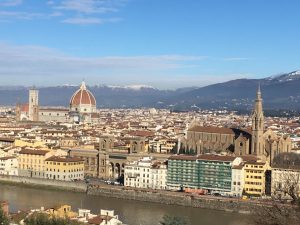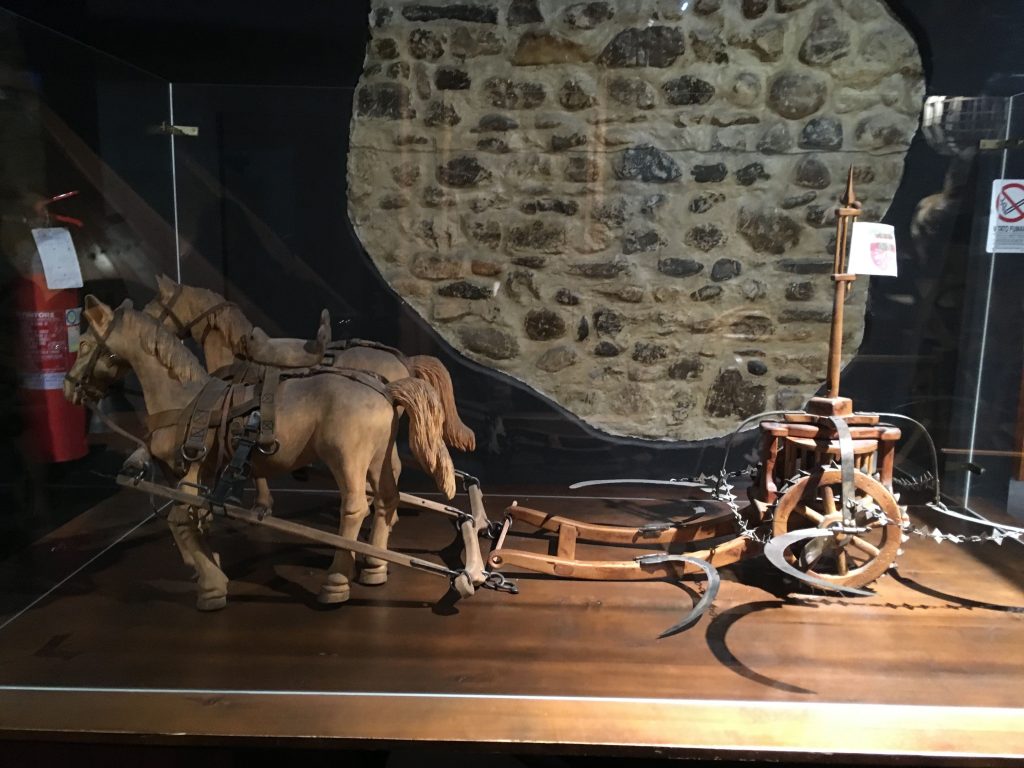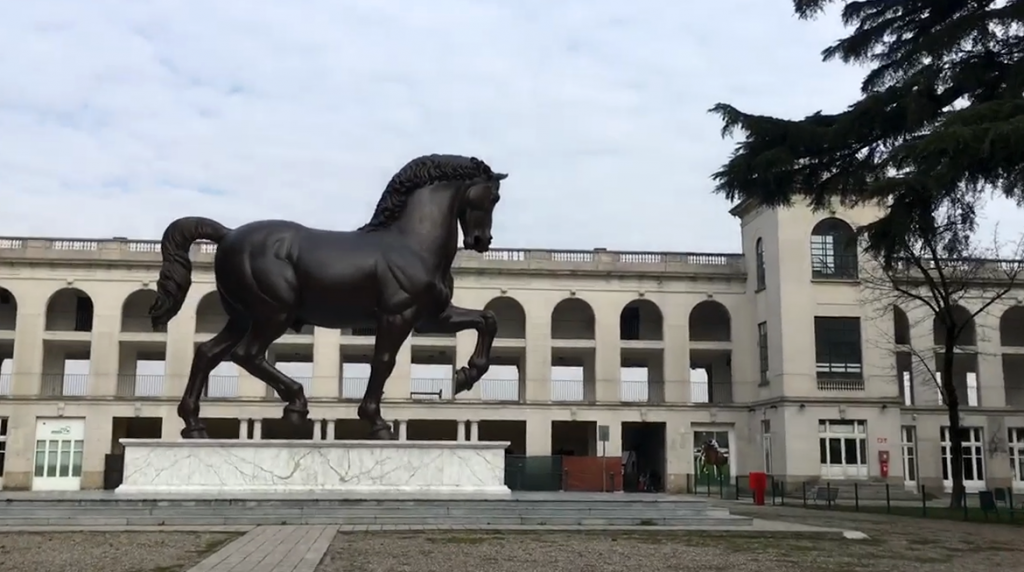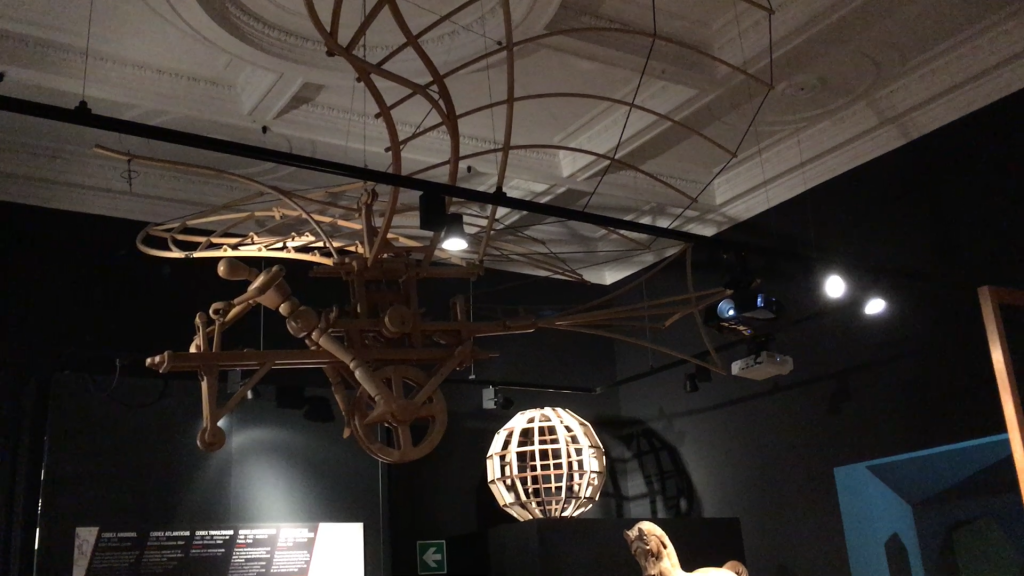Leonardo Da Vinci
A blog post by Greg

When we were touring shows in Italy in February 2018, and I realised that we had a weekend free for Valentine’s Day (our last Valentine’s Day before our wedding) I decided to take Felicity somewhere special. Venice was ruled out as we had already been there for the carnival, and so the city of Firenze, or Florence as it is known in English, sprung immediately to mind!
I had been there once before for a brief visit, and knew that it was a lovely looking place, and I also knew that there were several museums based on the work of Leonardo da Vinci (who I have long been interested in) which I was sure that Felicity wouldn’t mind me looking round while we were there – not that I had anything other than a romantic motive for choosing Florence as a destination, of course! I did, however, feel that it gives me the perfect excuse to do a blog post about Da Vinci!
For those of you who have never heard of Leonardo da Vinci (if such a person exists), or more likely if you have a vague idea that he was an artist, an inventor, and that one of the Teenage Mutant Ninja Turtles was named after him, I will take a moment to give you a quick overview of who he was. This, as a rarity, is something I am actually highly qualified for, as Leonardo da Vinci was the subject of a minor module in my Open University History BA nearly fifteen years ago, so I can probably legitimately count myself as a Da Vincian (definitely a word) Scholar.

Da Vinci was born in 1452, in or close to the town of Vinci, which was at that time part of the Republic of Florence, Tuscany. At that time there was no unified country of Italy – what we would now call Italy was at that time divided into a series of independent city states, such as Florence, Venice, and the Kingdom of Naples to name a few. His father, Ser Piero da Vinci, was a legal notary while his mother, Caterina, was from the lower classes, and so were not destined to be married, and so Leonardo was born out of wedlock, and his parents each married other people the year after his birth.
Despite their class differences, Leonardo’s illegitimacy, and the fact that they had married other people, Leonardo seems, from what little we know of his childhood, to have been raised by both sides of his family. It is likely that his mother raised him in his earliest years, but by the time he was five he was living with his grandfather on his father’s side, where he had a basic education in writing, reading and maths.
His story really takes off when, at the age of 14, he found a position as a ‘studio boy’ in the workshop of the sculptor and painter Andrea del Verrocchio (who himself had worked under Donatello, another master sculptor, who also gave his name to one of the Teenage Mutant Ninja Turtles). Leonardo worked his way up to apprentice by the time he was seventeen, and spent seven years learning a huge range of technical and artistic skills. In those times a painting or sculpture would be attributed to the ‘master’ whose studio produced it, and so there is much interest amongst art historians about which parts of Verrocchio’s works would have been painted by a young Leonardo, and it is even believed that Leonardo was the model for some of Verrocchio’s works at the time.
When Leonardo was twenty years old, in 1472, having qualified to become a ‘master’ himself, Leonardo’s father set the young artist up with his own studio, from which time Leonardo would get his own name on his artwork, and, through working on commissions for great families such as the Medici family in Florence, the Sforza family in Milan, and other patrons, he would create some of the most famous artwork in the world today, such as ‘The Last Supper’ and, of course, ‘The Mona Lisa’.
I must admit, however, that it is not Leonardo’s artistic works that particularly interest me, but rather it is when the art drifted into science. He gained permission, for example, to dissect human bodies, and made many detailed drawings of different parts of the body, the muscles, and skeletons, and showed interest in how these worked together, and how they allowed for movement.
He also studied and drew other animals as well, including cows, monkeys and bears, but to me the most important of these was his study of birds, because here we link to another string in Leonardo’s bow, engineering and invention!
In 1482 he had written a letter to Ludovico il Moro of Milan, offering to design machines to protect the city as well as machines to assist in a battle against another city, and he continued this work when he moved to Venice in 1499.

In Da Vinci’s surviving journals there are a lot of inventions drawn, including the horse-drawn bladed chariot shown above. Of course, the term ‘invention’ may be slightly misleading for a lot of these drawings, for while much of what he invented worked and indeed proved useful, other drawings might be most kindly described as works in progress. Realistically these were concept designs, ideas which he had drawn which were either impractical in the real world, or that he just didn’t have the technology, time, or resources to fully work out.
It may seem rude to suggest that the great Leonardo da Vinci would just give up on an idea due to a lack of patience, and perhaps this is unfair. Perhaps it was more that he just lost interest in things when some new idea came along, or that he took too long over the details so that he never got around to completion. A prime example of this would have to be the ‘Gran Cavallo’, the ‘Great Horse’ in Milan.
As mentioned, Leonardo at one point went to work for Ludovico il Moro in Milan, and had offered his services as an engineer as well as an artist, and these two skills would be combined in the creation of the ‘Gran Cavallo’, which was intended to be the largest statue of a horse ever created as a monument to Ludovico’s father, Francesco Sforza.
The aim was to build a bronze sculpture of a horse, with Da Vinci’s usual realism, but standing nearly twenty-six feet high! There were few people who could even begin to take on this challenge, but Da Vinci faced it head on, and went to work with his usual scientific focus. He studied horses intently, making many sketches and producing writings on their anatomy to make sure that every detail of the horse would be correct. He figured out how they could cast such a vast statue, producing another work detailing how the separate pieces would be cast, and the form of the iron supports which would be needed inside the hollow structure to keep it from collapse.
A full eleven years after receiving the commission, Da Vinci produced a full size clay model of the horse, but a month later the Duke of Milan, Ludovico, had to use the bronze which had originally been gathered to make the statue to make cannons instead to defend the city, and the clay model was destroyed at the end of the century by French soldiers who invaded the city, and by rain and cold.
For centuries it was unknown whether Da Vinci’s design would, in fact, have worked, or whether the reason he had gone so long without starting to cast the statue was because he hadn’t really figured out a way to do it. It wasn’t until the 20th Century that an attempt was made to go back through Leonardo’s works and to finally cast the horse, and in 1997, over five hundred years after the clay model was created, ‘Leonardo’s Horse’ was finally placed into position in front of the Milan Hippodrome, which we got to go and see earlier in our tour in Italy!

All of this brings us back to Florence, and to Da Vinci’s study of birds, all moving together to the reason why I was so keen to get to see one of the Da Vinci museums in town. Of all the studies that Da Vinci ever undertook, the one that has always fascinated me most are the studies which led to him preparing his ‘Codex On The Flight Of Birds’, and his fascination with the possibility of allowing people to fly!
According to Da Vinci, his interest in birds was linked to his earliest memory being related to a bird landing on his pram as a baby.
“In the first recollection of my infancy it seemed to me that, while I was in my cradle a kite came to me and opened my mouth with its tail.”
Whether this story was true or not, Da Vinci showed a lot of interest in flying creatures, making numerous sketches and studies of both birds and bats to try to understand what gave them the ability to fly.
There are some who claim that he invented a forerunner to the helicopter, and it is true that one of his early designs for a flying machine, the Aerial Screw, would have used rotation in the same way as a helicopter. It was actually based on the water screw, which was used for drawing water upwards, and although it certainly has the concept of using rotation to move upwards through the air, it was manpowered and so would not have rotated fast enough, even had the concept been perfect.
In fact, despite all of his studies and designs, and even though he wrote about concepts for a flying machine in the Codex On The Flight Of Birds, Da Vinci never actually achieved flight, however I do find it incredible how much his other invention, Leonardo’s Ornithopter, resembles a plane. There is also something wonderful about the way it looks, the idea behind it, and the details he went into, and it was this that I most wanted to see in the museum.

He obviously didn’t understand aerodynamics as we do today, and therefore didn’t have a wing shape which would allow his flying machine to work as a modern aeroplane does. Actually, that sentence is inaccurate because I used the word ‘we’. I’ll be honest, I don’t entirely understand how the aerodynamics work, I just know that they do. Were I to find myself having to invent a flying machine from scratch I would probably do what Da Vinci did – look at birds and conclude that the wings of the plane should flap, and so that is what he designed.
In the Codex he discussed what material it should be made of (not any metal apparently because it would break under stress!), and even goes so far as to give instructions for flying the machine, and how to keep it flying, all with accompanying diagrams of birds in flight to show how they work.
This is why I wanted to see the Da Vinci museum, and why I have long been interested in Da Vinci.

He always strikes me as a practical dreamer, something which I also strive to be in my life. He looked at things which many thought were impossible, and wanted to achieve them, even if he didn’t know how it could be achieved when he set out.
He didn’t however, just hope that things would work, he didn’t wait around for an answer to suddenly drop into his lap or spring into his mind, but rather he set to work studying, examining, enquiring, and trying to find a way to achieve what he wanted!
When I first told Felicity that we could make travel documentaries our lives, I really had no idea how – but I took Da Vinci’s example, and am constantly studying, looking into new ways of doing things, and learning from others, to find practical ways to make our dream work!
Happy adventuring, and please, take unbelievably good care of yourselves, and of each other!
Greg
P.S.
If you enjoyed this blog post, please leave a comment and say ‘hello’!
For information on all of our projects, visit: www.gregandfelicityadventures.com
Follow us on Instagram at: https://www.instagram.com/gregandfelicity
Like us on Facebook at: https://www.facebook.com/GregandFelicityAdventures
There are various places you can watch our documentaries and series!
Seeking Cetaceans In Scotland: A two-part documentary about the work of the Cetacean Research and Rescue Unit as they work to help whales, dolphins and porpoises in the Moray Firth in Scotland:
Free in the USA on Tubi TV at:
https://tubitv.com/movies/678018/seeking-cetaceans-in-scotland
Free Worldwide on PlexTV at:
https://watch.plex.tv/movie/seeking-cetaceans-in-scotland
With a library card on the Hoopla service where applicable:
https://www.hoopladigital.com/title/15313766
Free in the USA on Xumo at:
https://www.xumo.tv/channel/99991731/free-documentaries?v=XM00ILOFXCKLUC&p=74071
Buy it without ads Amazon’s Prime Video at:
UK: https://www.amazon.co.uk/dp/B09RVWVFCV
USA: https://www.amazon.com/dp/B09RVWJGY1
(Greg and Felicity are donating half of our streaming income on this documentary to support the CRRU).
Available to buy on DVD (with £5 from each donated to the charity): https://ko-fi.com/s/73e469d114
ROMANIA: SEEKING DRACULA’S CASTLE: Our travel documentary looking into the history, legend and castles connected to Vlad Dracula III, sometimes known as Vlad the Impaler, and a journey around Romania:
Free Worldwide on Plex: https://watch.plex.tv/movie/romania-seeking-draculas-castle
Free (USA) on Tubi: https://tubitv.com/movies/579192/romania-seeking-dracula-s-castle
Prime Video (From £1.99, no Ads) (UK): https://www.amazon.co.uk//dp/B08RDPZP14
Prime Video (From $1.99, no Ads) (USA): https://www.amazon.com/dp/B08RDJR4F2
TURKEY: FAIRY CHIMNEYS AND UNDERGROUND CITIES: A travel documentary across Turkey, from the Fairy Chimneys and Underground Cities of Cappadocia to the ancient Greek ruins of Ephesus and Hierapolis:
Prime Video UK (From £2.49, no Ads): https://www.amazon.co.uk/Turkey-Fairy-Chimneys-Underground-Cities/dp/B09KKSZLRW
Prime Video USA (From $1.99, no Ads): https://www.amazon.com/Turkey-Fairy-Chimneys-Underground-Cities/dp/B09KK6VDJB
Free Worldwide on Plex: https://watch.plex.tv/movie/turkey-fairy-chimneys-and-underground-cities
Free (USA) on Tubi: https://tubitv.com/movies/579225/turkey-fairy-chimneys-and-underground-cities
Greg Chapman’s Magic Show: An eight-part series of magic and entertainment with Greg:
Free in the USA on Tubi at: https://tubitv.com/series/300008713/greg-chapman-s-magic-show
Free worldwide on Plex: https://watch.plex.tv/show/greg-chapmans-magic-show/season/1
Available to buy on DVD: https://ko-fi.com/s/7c1bc10a08
Mexico: Mayan Mystery and Marine Majesty: Filmed on our honeymoon in Mexico in 2019, our first travel documentary took us through the ancient sites of Teotihuacan, Uxmal, El Tajin, Palenque, Chichen Itza and Calakmul, and then on to see the whales of Magdalena Bay, whale sharks of La Paz, and more.
Watch free on YouTube: https://youtu.be/yfMpD868MHU
The Isle of Man: Railways, Castles and Seals: Our second travel documentary took us to the Isle of Man!
Watch free on YouTube: https://youtu.be/uCpUa6XEkbg